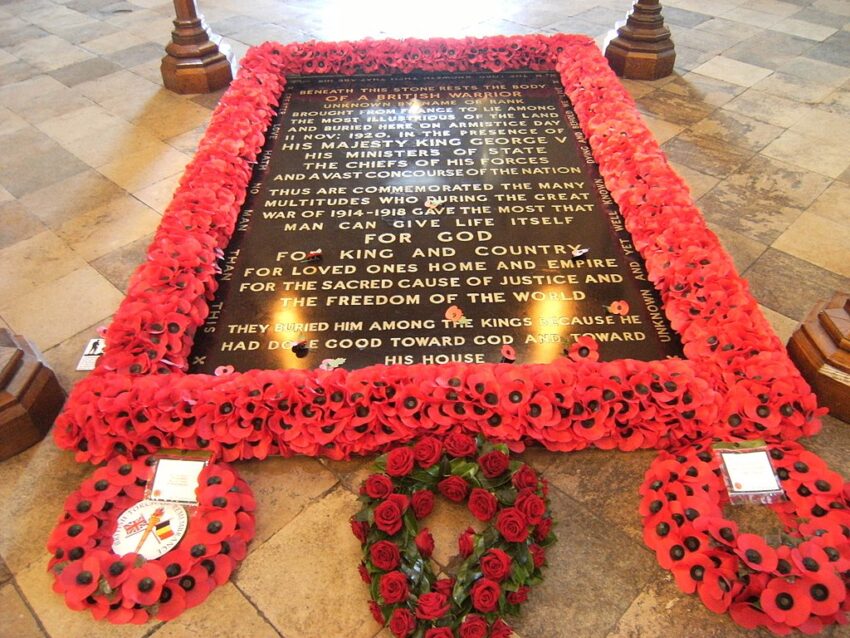
If you should come into the Abbey through the West Door and into the nave, you will walk over the memorial to Sir Winston Churchill, but everyone, whether commoner or Queen, walks around the Tomb of the Unknown Warrior.
This is the last resting place of a British soldier, “known only to God” and is a commemoration of British war dead, conceived in the aftermath of WW1. The red flowers around it are paper poppies, a symbol of remembrance from a First World War poem – “In Flanders’ fields the poppies blow, between the crosses, row on row”. Poppies thrive in ground that has been churned up, so the bombed out land and the grave sites away from the front line encouraged their blooms.
The 1914-1918 war killed millions of soldiers. Over 880,00 British and Commonwealth troops died – more than in the second world war. Every town, every village in Britain lost men. Nearly every family was affected. It’s impossible to underestimate the personal and national trauma of the conflict.
The bodies weren’t repatriated as they are today; they were buried in war cemeteries in France and Belgium and beyond. So those who had lost loved ones had no place to grieve. Worse, many bodies were never recovered; wives and mothers would just be told that their husband or son was “missing in action”. Bodies are still being found to this day on the farmland that was the Western Front.
An army chaplain called David Railton came up with the idea of a memorial in this, the national church, and the idea was backed by Dean Herbert Ryle.
In early November 1920 the bodies of four unidentified soldiers from the various main battle areas of the Western Front were brought together, and one of these was randomly chosen.
This body was put into a plain coffin, which was then put into a thick coffin made from oak from trees from Hampton Court, along with a 16th century crusader’s sword from the Royal Armouries.
That was then covered by the flag that is now on display in St George’s Chapel in the Abbey – the ‘padre’s flag’ – that Railton had used as an altar cloth during the war, and borne in procession to Boulogne – a procession a mile long – placed on HMS Verdun and brought to Dover.
On the morning of 11 November 1920 the coffin travelled from Dover by train to Victoria station, the roof of the carriage in which the body travelled was painted white, so the crowds gathering on the bridges along the route could identify it. After arriving at platform 8 at Victoria (where a memorial still exists) it was placed on a gun carriage drawn by six black horses, and carried through the streets to Whitehall, pausing there as the King George V, in his field marshal’s uniform, unveiled Lutyens’s Cenotaph.
It was then brought through a guard of honour of 100 holders of the Victoria Cross, the highest British award for bravery, and through the North door into the Abbey, where the Unknown Warrior was finally buried in soil from the battlefields and a slab of Belgian granite was put over the grave.
The Unknown Warrior is representative of every dead soldier. As it says on the inscription – “unknown, yet well known”
(There’s a little more on the Tomb of the Unknown Warrior in my video tour – WW1 Memorials)
To get more like this, sign up for my newsletter. Every month (or so) I’ll send you the latest posts from the site, and some of the most popular bits of the archive.
